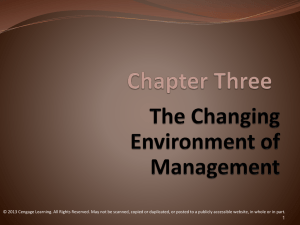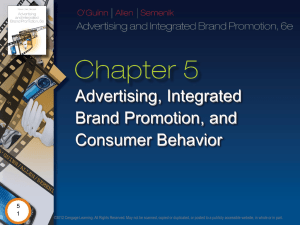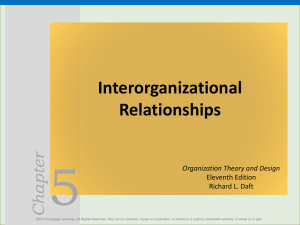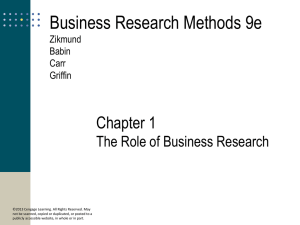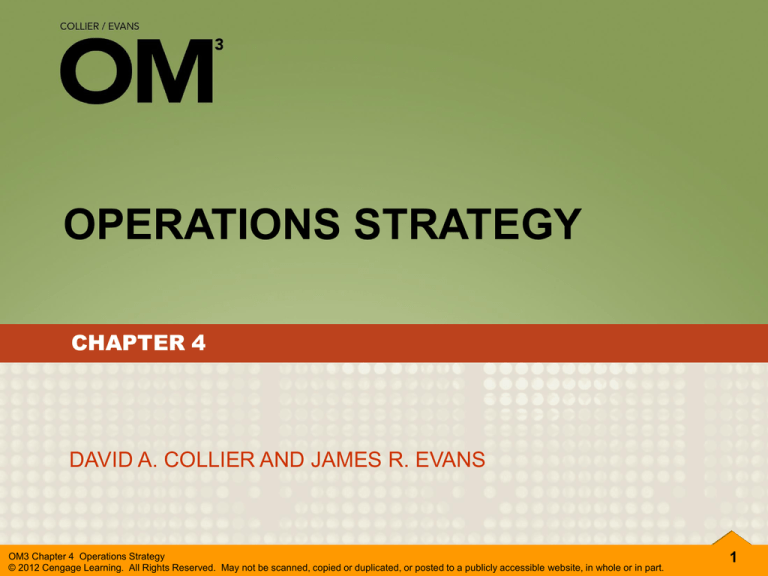
OPERATIONS STRATEGY
CHAPTER 4
DAVID A. COLLIER AND JAMES R. EVANS
OM3 Chapter 4 Operations Strategy
© 2012 Cengage Learning. All Rights Reserved. May not be scanned, copied or duplicated, or posted to a publicly accessible website, in whole or in part.
1
CHAPTER 4
OPERATIONS STRATEGY
LO1 Explain how organizations seek to gain
competitive advantage.
LO2 Explain approaches for understanding customer
requirements.
LO3 Describe how customers evaluate goods and
services.
LO4 Explain the five key competitive priorities.
LO5 Explain the role of OM and operations strategy in
strategic planning.
LO6 Describe Hill’s framework for operations strategy.
OM3 Chapter 4 Operations Strategy
© 2012 Cengage Learning. All Rights Reserved. May not be scanned, copied or duplicated, or posted to a publicly accessible website, in whole or in part.
2
r
CHAPTER 4
OPERATIONS STRATEGY
ival golf club equipment manufacturers TaylorMade and Callaway
are both based in Carlsbad, California. That’s about where the
similarity ends. Callaway made clubs for average golfers, while
TaylorMade took the clubs pro golfers were using and adjusted them to
suit amateurs. Callaway focused on management and production
efficiency while sticking to core product designs, much the way Ford
built cars around a basic chassis. TaylorMade, however, was constantly
reinventing its products lines, and in an industry that expected product
cycles to last 18 months or longer, began releasing new drivers and
irons in rapid-fire succession. Even new product launches show the
difference between these companies: Callaway typically launched
products with lengthy PowerPoint presentations, while TaylorMade
turned them into huge pep rallies. TaylorMade’s strategy seems to have
paid off; late in 2003 it overtook Callaway in market share for
metalwoods.
OM3 Chapter 4 Operations Strategy
© 2012 Cengage Learning. All Rights Reserved. May not be scanned, copied or duplicated, or posted to a publicly accessible website, in whole or in part.
3
CHAPTER 4
OPERATIONS STRATEGY
What do you think?
What implications would the
different strategies chosen by
Callaway and TaylorMade—
sticking to core product
designs versus continual
innovation—have for key
operations management
decisions such as outsourcing
and designing flexibility into
their processes?
OM3 Chapter 4 Operations Strategy
© 2012 Cengage Learning. All Rights Reserved. May not be scanned, copied or duplicated, or posted to a publicly accessible website, in whole or in part.
4
CHAPTER 4
OPERATIONS STRATEGY
Gaining Competitive Advantage
Competitive advantage denotes a firm’s ability to
achieve market and financial superiority over its
competitors.
Creating competitive advantage requires:
1. Understanding customer needs and expectations and
how the value chain can best meet these through
designing and delivering customer benefit packages.
2. Building and leveraging operational capabilities to
support desired competitive priorities.
OM3 Chapter 4 Operations Strategy
© 2012 Cengage Learning. All Rights Reserved. May not be scanned, copied or duplicated, or posted to a publicly accessible website, in whole or in part.
5
CHAPTER 4
OPERATIONS STRATEGY
Understanding Customer Wants and Needs
• Order qualifiers are basic customer
expectations generally considered the
minimum performance level required to stay
in business.
• Order winners are goods and service
features and performance characteristics that
differentiate one customer benefit package
from another and win the customer’s
business.
OM3 Chapter 4 Operations Strategy
© 2012 Cengage Learning. All Rights Reserved. May not be scanned, copied or duplicated, or posted to a publicly accessible website, in whole or in part.
6
CHAPTER 4
OPERATIONS STRATEGY
OM3 Chapter 4 Operations Strategy
© 2012 Cengage Learning. All Rights Reserved. May not be scanned, copied or duplicated, or posted to a publicly accessible website, in whole or in part.
7
CHAPTER 4
OPERATIONS STRATEGY
Evaluating Goods and Services
• Search attributes are those that a customer
can determine prior to purchasing the goods
and/or services.
•
These attributes include things like color, price,
freshness, style, fit, feel, hardness, and smell.
OM3 Chapter 4 Operations Strategy
© 2012 Cengage Learning. All Rights Reserved. May not be scanned, copied or duplicated, or posted to a publicly accessible website, in whole or in part.
8
CHAPTER 4
OPERATIONS STRATEGY
Evaluating Goods and Services
• Experience attributes are those that can be
discerned only after purchase or during
consumption or use.
•
Examples are friendliness, taste, wearability,
safety, fun, and customer satisfaction.
OM3 Chapter 4 Operations Strategy
© 2012 Cengage Learning. All Rights Reserved. May not be scanned, copied or duplicated, or posted to a publicly accessible website, in whole or in part.
9
CHAPTER 4
OPERATIONS STRATEGY
Evaluating Goods and Services
• Credence attributes are any aspects of a good
or service that the customer must believe in, but
cannot personally evaluate even after purchase
and consumption.
•
Examples would include the expertise of a
surgeon or mechanic, the knowledge of a tax
advisor, or the accuracy of tax preparation
software.
OM3 Chapter 4 Operations Strategy
© 2012 Cengage Learning. All Rights Reserved. May not be scanned, copied or duplicated, or posted to a publicly accessible website, in whole or in part.
10
CHAPTER 4
OPERATIONS STRATEGY
Exhibit 4.1 How Customers Evaluate Goods and Services
Source: Adapted from V. A. Zeithamel, “How Consumer Evaluation Processes Differ Between Goods and Services,” in J. H. Donnelly and W. R. George, eds.,
Marketing in Services, published by the American Marketing Association, Chicago, 1981, pp. 186–199.
OM3 Chapter 4 Operations Strategy
© 2012 Cengage Learning. All Rights Reserved. May not be scanned, copied or duplicated, or posted to a publicly accessible website, in whole or in part.
11
CHAPTER 4
OPERATIONS STRATEGY
Customers evaluate services in ways that are often
different from goods, such as:
• Customers seek and rely more on information from
•
personal sources than from non-personal sources when
evaluating services prior to purchase. Operations must
ensure that accurate information is available.
Customers perceive greater risks when buying services
than when buying goods. Because services are intangible,
customers cannot look at or touch them prior to the
purchase decision.
These insights help to explain why it is more difficult to
design services and service processes than goods and
manufacturing operations.
OM3 Chapter 4 Operations Strategy
© 2012 Cengage Learning. All Rights Reserved. May not be scanned, copied or duplicated, or posted to a publicly accessible website, in whole or in part.
12
CHAPTER 4
OPERATIONS STRATEGY
Competitive Priorities
Competitive priorities represent the strategic
emphasis that a firm places on certain performance
measures and operational capabilities within a value
chain.
Key competitive priorities are:
• Cost
• Quality
• Time
• Flexibility
• Innovation
OM3 Chapter 4 Operations Strategy
© 2012 Cengage Learning. All Rights Reserved. May not be scanned, copied or duplicated, or posted to a publicly accessible website, in whole or in part.
13
CHAPTER 4
OPERATIONS STRATEGY
Competitive Priority – Cost
• Almost every industry has a low price market
segment. Examples include Honda Motor Co.,
Marriott's Fairfield Inns, Merck-Medco On-line
Pharmacy, Southwest Airlines, and Walmart.
• Low cost results from high productivity, high
capacity utilization, and economies of scale.
Continuous improvement is essential to achieve a
low-cost competitive advantage.
OM3 Chapter 4 Operations Strategy
© 2012 Cengage Learning. All Rights Reserved. May not be scanned, copied or duplicated, or posted to a publicly accessible website, in whole or in part.
14
CHAPTER 4
OPERATIONS STRATEGY
Competitive Priority – Quality
PIMS Associates, Inc., a subsidiary of the Strategic Planning
Institute, found that:
• Businesses offering premium quality goods usually have
large market shares and were early entrants into their
markets.
• Quality is positively and significantly related to a higher
return on investment for almost all kinds of market
situations.
• A strategy of quality improvement usually leads to increased
market share, but at a cost in terms of reduced short-run
profitability.
• High goods quality producers can usually charge premium
prices.
OM3 Chapter 4 Operations Strategy
© 2012 Cengage Learning. All Rights Reserved. May not be scanned, copied or duplicated, or posted to a publicly accessible website, in whole or in part.
15
CHAPTER 4
OPERATIONS STRATEGY
Exhibit 4.2 Interlinking Quality and Profitability Performance
OM3 Chapter 4 Operations Strategy
© 2012 Cengage Learning. All Rights Reserved. May not be scanned, copied or duplicated, or posted to a publicly accessible website, in whole or in part.
16
CHAPTER 4
OPERATIONS STRATEGY
Competitive Priority – Time
•
Time is perhaps the most important source of
competitive advantage.
•
Customers demand quick response, short waiting
times, and consistency in performance.
•
Many firms use time as a competitive weapon to
create and deliver superior goods and services,
such as Charles Schwab, CNN, Dell, and FedEx.
OM3 Chapter 4 Operations Strategy
© 2012 Cengage Learning. All Rights Reserved. May not be scanned, copied or duplicated, or posted to a publicly accessible website, in whole or in part.
17
CHAPTER 4
OPERATIONS STRATEGY
Competitive Priority – Time
•
Speeding up work processes improves customer
response. Deliveries can be made faster, and
more often on-time.
•
Time reductions can only be accomplished only
by streamlining and simplifying processes and
value chains to eliminate non-value-added steps
such as rework and waiting time.
•
Time reductions also drive improvements in
quality, cost, and productivity.
OM3 Chapter 4 Operations Strategy
© 2012 Cengage Learning. All Rights Reserved. May not be scanned, copied or duplicated, or posted to a publicly accessible website, in whole or in part.
18
CHAPTER 4
OPERATIONS STRATEGY
Competitive Priority – Flexibility
•
Success in global markets requires both design
and demand flexibility. Flexibility is manifest in
mass customization strategies.
• Mass customization is being able to make
whatever goods and services the customer
wants, at any volume, at any time for anybody,
and for a global organization, from any place in
the world.
OM3 Chapter 4 Operations Strategy
© 2012 Cengage Learning. All Rights Reserved. May not be scanned, copied or duplicated, or posted to a publicly accessible website, in whole or in part.
19
CHAPTER 4
OPERATIONS STRATEGY
Competitive Priority – Flexibility
Examples:
• Sign-tic company signs that are uniquely designed for each
customer from a standard base sign structure
• Business consulting
• Levi’s jeans that are cut to exact measurements
• Personal Web pages
• Estate planning
• Motorola pagers customized in different colors, sizes, and
shapes
• Personal weight training programs
• Modular furniture that customers can configure to their
unique needs and tastes
OM3 Chapter 4 Operations Strategy
© 2012 Cengage Learning. All Rights Reserved. May not be scanned, copied or duplicated, or posted to a publicly accessible website, in whole or in part.
20
CHAPTER 4
OPERATIONS STRATEGY
Competitive Priority – Innovation
• Innovation is the discovery and practical
application or commercialization of a device,
method, or idea that differs from existing
norms.
•
Innovative companies focus on outstanding
product research, design, and development;
high product quality; and the ability to
modify production facilities to produce new
products frequently.
OM3 Chapter 4 Operations Strategy
© 2012 Cengage Learning. All Rights Reserved. May not be scanned, copied or duplicated, or posted to a publicly accessible website, in whole or in part.
21
CHAPTER 4
OPERATIONS STRATEGY
Solved Problem
Define the customer benefit package for a health
club or recreation center and use this to describe
the organization’s strategic mission, strategy,
competitive priorities, and how it wins customers.
OM3 Chapter 4 Operations Strategy
© 2012 Cengage Learning. All Rights Reserved. May not be scanned, copied or duplicated, or posted to a publicly accessible website, in whole or in part.
22
CHAPTER 4
Example Solution
Mission: The mission of our health
club is to offer many pathways to a
healthy living style and body.
OPERATIONS STRATEGY
Food
Child
Care
Personal
Trainer
Exercise
Classes
Healthy
Mind and
Body
Swim
Lessons
Diet and
Nutrition
Massage
Services
Strategy: We strive to provide our customers with superior:
•
•
•
•
Ways to improve and maintain your body and mind’s health
and well-being.
Friendly professional staff that care about you.
Clean facilities, equipment, uniforms, parking lot, food
service, and the like.
Customer convenience (location, food, communication,
schedules, etc.).
OM3 Chapter 4 Operations Strategy
© 2012 Cengage Learning. All Rights Reserved. May not be scanned, copied or duplicated, or posted to a publicly accessible website, in whole or in part.
23
CHAPTER 4
OPERATIONS STRATEGY
Example Solution (continued)
Competitive Priorities:
1. Many pathways to healthy living and a healthy body
(design flexibility)
2. Friendly professional staff and service encounters
(service quality)
3. Everything is super-clean (goods and environmental
quality)
4. Customer convenience in all respects (time)
5. Price (cost)
How to win customers? Providing a full service health
club with superior service, staff, and facilities.
OM3 Chapter 4 Operations Strategy
© 2012 Cengage Learning. All Rights Reserved. May not be scanned, copied or duplicated, or posted to a publicly accessible website, in whole or in part.
24
CHAPTER 4
OPERATIONS STRATEGY
Strategic Planning
• Strategy is a pattern or plan that integrates an
organization’s major goals, policies, and action
sequences into a cohesive whole.
•
Effective strategies develop around a few key
competitive priorities, such as low cost or fast
service time, which provide a focus for the
entire organization and exploit an organization’s
core competencies (the strengths unique to
that organization).
OM3 Chapter 4 Operations Strategy
© 2012 Cengage Learning. All Rights Reserved. May not be scanned, copied or duplicated, or posted to a publicly accessible website, in whole or in part.
25
CHAPTER 4
OPERATIONS STRATEGY
Strategic Planning
• Strategic planning is the process of determining
long-term goals, policies, and plans for an
organization.
• The businesses in which the firm will participate are
often called strategic business units (SBUs), and
are usually defined as families of goods or services
having similar characteristics or methods of creation.
• Strategy is the result of a series of hierarchical
decisions about goals, directions, and resources.
OM3 Chapter 4 Operations Strategy
© 2012 Cengage Learning. All Rights Reserved. May not be scanned, copied or duplicated, or posted to a publicly accessible website, in whole or in part.
26
CHAPTER 4
OPERATIONS STRATEGY
Three Levels of Strategy
1. A corporate strategy is necessary to define the
businesses in which the corporation will participate and
develop plans for the acquisition and allocation of
resources among those businesses.
2. A business strategy defines the focus for SBUs. The
major decisions involve which markets to pursue and how
best to compete in those markets; that is, what
competitive priorities the firm should pursue.
3. A functional strategy is the set of decisions that each
functional area—marketing, finance, operations, research
and development, engineering, and so on—develops to
support its particular business strategy.
OM3 Chapter 4 Operations Strategy
© 2012 Cengage Learning. All Rights Reserved. May not be scanned, copied or duplicated, or posted to a publicly accessible website, in whole or in part.
27
CHAPTER 4
OPERATIONS STRATEGY
Operations Strategy
• The operations strategy defines how an
organization will execute its chosen
business strategies.
•
Developing an operations strategy involves
translating competitive priorities into
operational capabilities by making a variety
of choices and trade-offs for design and
operating decisions.
OM3 Chapter 4 Operations Strategy
© 2012 Cengage Learning. All Rights Reserved. May not be scanned, copied or duplicated, or posted to a publicly accessible website, in whole or in part.
28
CHAPTER 4
OPERATIONS STRATEGY
Pal’s Sudden Service
Vision—To be the preferred quick service restaurant in our
market achieving the largest market share by providing:
• The quickest, friendliest, most accurate service available
• A focused menu that delights customers
• Daily excellence in product, service, and systems
•
•
execution
Clean, organized, sanitary facilities
Exceptional value
What kind of an operations strategy might Pal’s have? How
can operations help achieve this vision?
OM3 Chapter 4 Operations Strategy
© 2012 Cengage Learning. All Rights Reserved. May not be scanned, copied or duplicated, or posted to a publicly accessible website, in whole or in part.
29
CHAPTER 4
OPERATIONS STRATEGY
Sustainability and Operations Strategy
•
Sustainability is an organizational strategy in many
firms and requires major changes in the culture of
an organization.
•
Many companies pursue sustainability through
their operations.
− Example: Dell, Inc. Design for Environment initiative to
control raw material acquisition, manufacturing
processes, and distribution programs while linking
green policies with consumer use and disposal.
OM3 Chapter 4 Operations Strategy
© 2012 Cengage Learning. All Rights Reserved. May not be scanned, copied or duplicated, or posted to a publicly accessible website, in whole or in part.
30
CHAPTER 4
OPERATIONS STRATEGY
OM3 Chapter 4 Operations Strategy
© 2012 Cengage Learning. All Rights Reserved. May not be scanned, copied or duplicated, or posted to a publicly accessible website, in whole or in part.
31
CHAPTER 4
OPERATIONS STRATEGY
A Framework for Operations Strategy
Operations design choices are the decisions
management must make as to what type of process
structure is best suited to produce goods or create
services.
•
•
•
•
•
•
Types of processes and alternative designs
Supply chain integration and outsourcing
Technology
Capacity and facilities (size, timing, location)
Inventory
Trade-off analysis
OM3 Chapter 4 Operations Strategy
© 2012 Cengage Learning. All Rights Reserved. May not be scanned, copied or duplicated, or posted to a publicly accessible website, in whole or in part.
32
CHAPTER 4
OPERATIONS STRATEGY
A Framework for Operations Strategy
Infrastructure focuses on the nonprocess
features and capabilities of the organization and
includes the workforce, operating plans and control
systems, quality control, organizational structure,
compensation systems, learning and innovation
systems, and support services.
OM3 Chapter 4 Operations Strategy
© 2012 Cengage Learning. All Rights Reserved. May not be scanned, copied or duplicated, or posted to a publicly accessible website, in whole or in part.
33
CHAPTER 4
OPERATIONS STRATEGY
Exhibit 4.3 Hill’s Strategy Development Framework
Source: T. Hill, Manufacturing Strategy: Text and Cases, 2nd ed., Burr Ridge, IL: Irwin Publishers, 1994, p. 28
OM3 Chapter 4 Operations Strategy
© 2012 Cengage Learning. All Rights Reserved. May not be scanned, copied or duplicated, or posted to a publicly accessible website, in whole or in part.
34
CHAPTER 4
OPERATIONS STRATEGY
Exhibit 4.4 Four Key Decision Loops in Terry Hill’s Generic Strategy Framework
OM3 Chapter 4 Operations Strategy
© 2012 Cengage Learning. All Rights Reserved. May not be scanned, copied or duplicated, or posted to a publicly accessible website, in whole or in part.
35
CHAPTER 4
OPERATIONS STRATEGY
Operations Strategy at McDonald’s
• McDonald's vision is to be the world's best quick
service restaurant experience. Being the best means
providing outstanding quality, service, cleanliness, and
value, so that we make every customer in every
restaurant smile. To achieve our vision, we focus on
three worldwide strategies:
(1) Be the Best Employer
(2) Deliver Operational Excellence
(3) Achieve Enduring Profitable Growth
OM3 Chapter 4 Operations Strategy
© 2012 Cengage Learning. All Rights Reserved. May not be scanned, copied or duplicated, or posted to a publicly accessible website, in whole or in part.
36
CHAPTER 4
OPERATIONS STRATEGY
Operations Strategy at McDonald’s
Four sustainability initiatives:
• Build a sustainable McDonald’s that involves all facets
•
•
•
of our business.
Commit to a three-pronged approach—reduce, reuse,
and recycle.
Strive to provide eco-friendly workplaces and
restaurants.
Work with suppliers and outside experts to
continuously improve purchasing decisions and
evaluation of supplier performance regarding animal
welfare.
OM3 Chapter 4 Operations Strategy
© 2012 Cengage Learning. All Rights Reserved. May not be scanned, copied or duplicated, or posted to a publicly accessible website, in whole or in part.
37
CHAPTER 4
OPERATIONS STRATEGY
Exhibit 4.5 McDonald’s Customer Benefit Package
OM3 Chapter 4 Operations Strategy
© 2012 Cengage Learning. All Rights Reserved. May not be scanned, copied or duplicated, or posted to a publicly accessible website, in whole or in part.
38
CHAPTER 4
OPERATIONS STRATEGY
Exhibit 4.6 Applying Hill’s Strategy Development Framework to McDonald’s (slide 1)
OM3 Chapter 4 Operations Strategy
© 2012 Cengage Learning. All Rights Reserved. May not be scanned, copied or duplicated, or posted to a publicly accessible website, in whole or in part.
39
CHAPTER 4
OPERATIONS STRATEGY
Exhibit 4.6 Applying Hill’s Strategy Development Framework to McDonald’s (slide 2)
OM3 Chapter 4 Operations Strategy
© 2012 Cengage Learning. All Rights Reserved. May not be scanned, copied or duplicated, or posted to a publicly accessible website, in whole or in part.
40
CHAPTER 4
OPERATIONS STRATEGY
Sustainable Lawn Care Case Study
1. Define Lawn Care’s current strategic mission, strategy,
competitive priorities, value chain, and how it wins customers.
What are the order qualifiers and winners? Draw the major
stages of the value chain with and without an application
service.
2. What problems, if any, do you see with Lawn Care’s current
strategy, vision, customer benefit package and value chain
design, and pre- and postservices?
3. Redo questions (1) and (2) and provide a new or revised
strategy and associated customer benefit package and value
chain that is more appropriate for today’s marketplace. What
does operations have to be good at to successfully execute
your revised strategy?
4. What are your final recommendations?
OM3 Chapter 4 Operations Strategy
© 2012 Cengage Learning. All Rights Reserved. May not be scanned, copied or duplicated, or posted to a publicly accessible website, in whole or in part.
41



